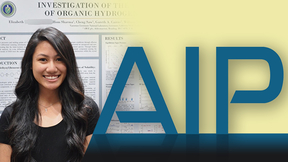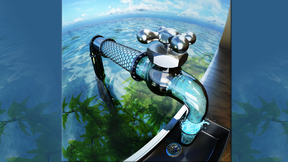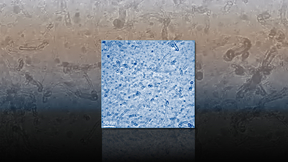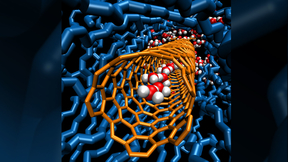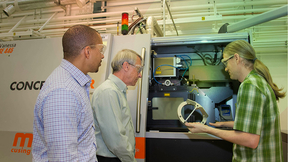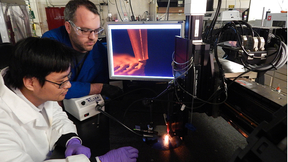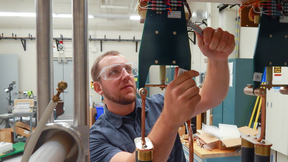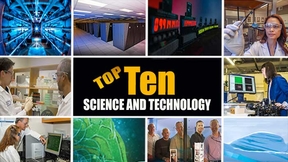Back
It’s rare for an undergraduate science student to appear as an author on a scientific journal paper, and when they do, theirs is usually the last name on the list. However, Elizabeth Sangalang, a graduating senior studying biochemistry at California State University East Bay, has landed a second-author credential through the research she completed as a summer intern at…
Lawrence Livermore (LLNL) scientists, in collaboration with researchers at Northeastern University, have developed carbon nanotube pores that can exclude salt from seawater. The team also found that water permeability in carbon nanotubes (CNTs) with diameters smaller than a nanometer (0.8 nm) exceeds that of wider carbon nanotubes by an order of magnitude. The nanotubes,…
Just as members of a marching band align themselves for a performance, carbon nanotubes create a similar configuration. Lawrence Livermore National Laboratory (LLNL) scientists recently used synchrotron X-ray scattering to fully capture the hierarchical structure in self-organized carbon nanotube materials from the atomic to micrometer scale. Their work, recently published…
A technology originally developed to smooth out and pattern high-powered laser beams for the National Ignition Facility (NIF) can be used to 3D print metal objects faster than ever before, according to a new study by Lawrence Livermore researchers. A team of Lab scientists report the findings in the latest issue of Optics Express, published online on May 15. This new…
Metal 3D printing has enormous potential to revolutionize modern manufacturing. However, the most popular metal printing processes, which use lasers to fuse together fine metal powder, have their limitations. Parts produced using selective laser melting (SLM) and other powder-based metal techniques often end up with gaps or defects caused by a variety of factors. To…
LIVERMORE, California -- Now in its third year, Lawrence Livermore National Laboratory (LLNL) is once again partnering with the State Theatre in Modesto to bring "Science on Screen" to the theater one Saturday a month from February through April.Science on Screen is a free, educational program geared to middle-, high-school and college students and creatively pairs cutting…
For the first time, Lawrence Livermore National Laboratory scientists and collaborators have captured a movie of how large populations of carbon nanotubes grow and align themselves.Understanding how carbon nanotubes (CNT) nucleate, grow and self-organize to form macroscale materials is critical for application-oriented design of next-generation supercapacitors, electronic…
Members of the LLNL team that created an environmentally reactive "second skin" for use in military uniforms of the future will be answering questions from the public during a Reddit "Ask Me Anything" online event beginning at 10 a.m. Wednesday. In addition to addressing just about any question on the minds of the Reddit community, Lab scientists Francesco Fornasiero, Ngo…
In work that aims to protect soldiers from biological and chemical threats, a team of Lawrence Livermore National Laboratory scientists has created a material that is highly breathable yet protective from biological agents. This material is the first key component of futuristic smart uniforms that also will respond to and protect from environmental chemical hazards. The…
Lawrence Livermore National Laboratory (LLNL) material scientists have found that 3D-printed foam works better than standard cellular materials in terms of durability and long-term mechanical performance.Foams, also known as cellular solids, are an important class of materials with applications ranging from thermal insulation and shock-absorbing support cushions to…
For the first time, Lawrence Livermore National Laboratory (LLNL) researchers have shown that carbon nanotubes as small as eight-tenths of a nanometer in diameter can transport protons faster than bulk water, by an order of magnitude.The research validates a 200-year old mechanism of proton transport.A nanometer is one billionth of a meter. By comparison, the diameter of a…
While the most common method of metal 3D printing is growing exponentially, moving forward from producing prototypes to manufacturing critical parts will be possible only by reaching a fundamental understanding of the complex physics behind the process, according to a new paper authored by Lawrence Livermore National Laboratory (LLNL) researchers. The powder bed fusion…
Reactive composite materials are everywhere, from the life-saving air bags in your car to the dazzling pyrotechnics in Fourth of July fireworks. But one of the main drawbacks to using these materials has been the unpredictability of their reactions.Historically, the way to alter the performance in reactive materials (i.e. thermites) has been to either change the…
Researchers from Lawrence Livermore National Laboratory (LLNL) and a Bay Area company are joining forces to explore how design software can accelerate innovation for three-dimensional printing of advanced materials.Under an 18-month Cooperative Research and Development Agreement (CRADA), LLNL will use state-of-the-art software for generative design from San Rafael-based…
A new type of graphene aerogel will make for better energy storage, sensors, nanoelectronics, catalysis and separations.Lawrence Livermore National Laboratory researchers have made graphene aerogel microlattices with an engineered architecture via a 3D printing technique known as direct ink writing. The research appears in the April 22 edition of the journal, Nature…
LIVERMORE, Calif. – General Electric (GE) and Lawrence Livermore National Laboratory (LLNL) recently received $540,000 to develop open-source algorithms that will improve additive manufacturing of metal parts.The award is from America Makes, the National Additive Manufacturing Innovation Institute that’s focused on helping the U.S. grow capabilities and strength in 3D…
LIVERMORE, California — California employers have created a pipeline to train and educate active-duty service members and veterans for careers in advance manufacturing to fill a workforce shortage for a burgeoning industry.Lawrence Livermore and Lawrence Berkeley national laboratories, NASA Ames Research Center and NASA Jet Propulsion Laboratory and other employers are…
In 2014, Lawrence Livermore National Laboratory (LLNL) built on a 62-year tradition of translating basic science into technologies that ensure national security, address pressing real world problems and expand the boundaries of fundamental science.The top stories of the year are a reflection of the Laboratory’s ability to apply its core national security competencies to a…
LIVERMORE, California – Lawrence Livermore National Laboratory researchers have developed an efficient method to measure residual stress in metal parts produced by powder-bed fusion additive manufacturing.This 3D printing process produces metal parts layer by layer using a high-energy laser beam to fuse metal powder particles. When each layer is complete, the build…
Materials like solid gels and porous foams are used for padding and cushioning, but each has its own advantages and limitations. Gels are effective as padding but are relatively heavy; gel performance can also be affected by temperature, and possesses a limited range of compression due to a lack of porosity. Foams are lighter and more compressible, but their performance is…

